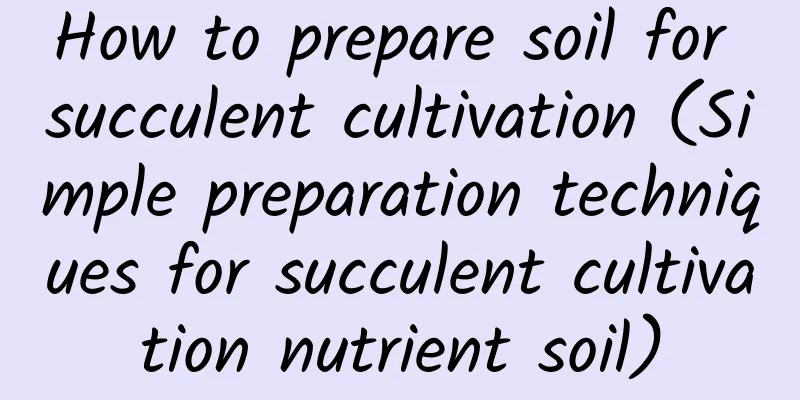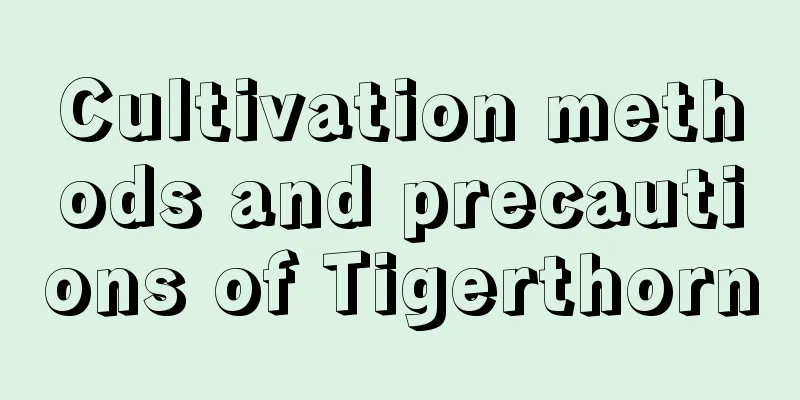How to prepare soil for succulent cultivation (Simple preparation techniques for succulent cultivation nutrient soil)

|
When growing succulents, many flower lovers always think that as long as they water them reasonably, fertilize them scientifically, and provide them with appropriate light exposure, it will be enough. In fact, this idea is too one-sided. Because no matter how carefully you care for it, it is based on the growth period of succulents, and there is actually a very critical step before planting succulents: Only by carefully preparing the soil and preparing suitable soil according to the growth characteristics of succulents can we better promote the growth of succulents. After all, most of the energy needed for growth is obtained from the soil. So how do you prepare soil for succulents? Before answering this question, you must first understand the soil characteristics of succulents. Succulents like to grow in loose, breathable, and well-drained soil. Such soil is very conducive to root development and will not accumulate water in the later stages. This reduces the chances of root rot and leaf waterlogging. Here are three ways to prepare the soil: ①Leaf mold, garden soil, coarse sandThis is a relatively common soil preparation method, in which leaf mold refers to soil mixed with dead branches, rotten leaves, rotten roots and other materials. This soil is rich in humus, has sufficient nutrients, and has good permeability and looseness, which can promote the growth and development of flower plants. But it also has a disadvantage, which is that it is easy to carry some diseases and insects, so it needs to be exposed to the sun and treated for insecticide before use. Garden soil is the soil around vegetable gardens and green belts. This type of soil is more common and very convenient to use. Generally, coarse sand has good drainage and air permeability, and is clean and hygienic and basically does not carry any germs. It is a good material for growing flowers and plants. Mix these three substances in a ratio of 1:2:2. The air permeability, drainage, fertility and looseness of the mixed soil can reach the best level , which can fully cater to the soil characteristics of succulents and is the first choice for succulents. ② Peat soil, granular soilPeat contains a lot of nutrients and is breathable and soft. Using it to grow succulents can promote the growth of their roots. However, peat also has its disadvantages, which is that it is easy to compact and is not conducive to the breathing of the roots, so it needs to be combined with granular soil. Because granular soil can increase the gaps between the soil and avoid compaction. Mix peat soil and granular soil in a certain amount, and the two complement each other. The soil prepared in this way is not only more fertile, but also more breathable and drainable. At the same time, this kind of nutrient soil also reduces the chance of soil compaction and hardening, which is very beneficial to the growth of succulents, allowing them to grow strong and have plump leaves. ③Perlite, coconut bran, peat soilMany people don’t know what perlite is. Perlite is actually a kind of glassy rock formed by the cooling of acidic lava erupted from volcanoes . This substance has strong air permeability and water permeability, can lock the nutrients in the soil and prevent them from being lost, and is the best substance for potting soil mixing. Coconut bran has good thermal insulation and moisture retention properties. It is ventilated and breathable, and most importantly, it is clean and hygienic. It is relatively cheap to purchase and can be used to grow succulents. However, it is not enough to plant succulents with only coconut coir and perlite, as this will easily make the root system of succulents fragile or even rot, so peat soil is also needed. Mix these three substances in a certain proportion and then they can be used to grow succulents. In fact, in addition to the above three methods, there are many other methods for preparing soil for succulents. No matter what materials or proportions are used, as long as the prepared soil can meet the growth needs of succulents and promote the growth of the root system, it will be fine. |
<<: How to propagate roses using rose seeds (rose seed planting methods and precautions)
Recommend
What flowers are suitable for east-facing balconies? What flowers and plants are suitable for east-facing balconies?
What flowers to plant on an east-facing balcony T...
Does the hanging bamboo plum bloom?
Does the hanging bamboo plum bloom? Hanging bambo...
The 30 most valuable types of garbage can be used to grow flowers without fertilizing or turning leaves!
Use it to grow flowers and no longer need to fert...
How many years does it take for azalea seedlings to bloom?
1. How many years does it take to bloom? Azalea i...
Cultivation methods and precautions of Ageratum
As long as you understand the habits of Ageratum,...
Bury a stick in the pot, and the soil will immediately become fertile, and the green ivy, Clivia... will grow like crazy as if they were injected with chicken blood!
Add some tea leaves to the soil and the green ivy...
How often should I water my fortune tree?
How often should I water my fortune tree? The mon...
How to fertilize keel flower
1. Nitrogen Fertilizer In order to make it grow w...
Causes of cactus root rot
Causes of cactus root rot 1. The low temperature ...
What to do if rosemary leaves dry up
Seedling stage Newly purchased plants will go thr...
Can the root rot of the lucky tree heal itself?
1. Can it heal itself? The rotten roots of the lu...
Can red spider lilies be planted at home?
When it comes to red spider lily, many people hav...
Do orchids like water and sunlight? Can they be exposed to the sun after watering?
1. Do orchids like water? Most orchids prefer wat...
Hydroponic methods in the city that never sleeps
Hydroponic vessels According to the specific cond...
Difference between sweet peas and snow peas
1. Leaf Difference The leaflets of sweet pea are ...









